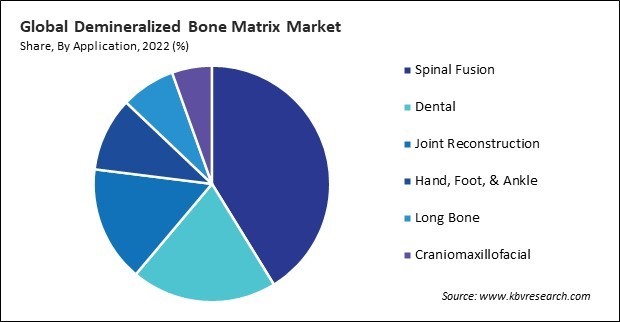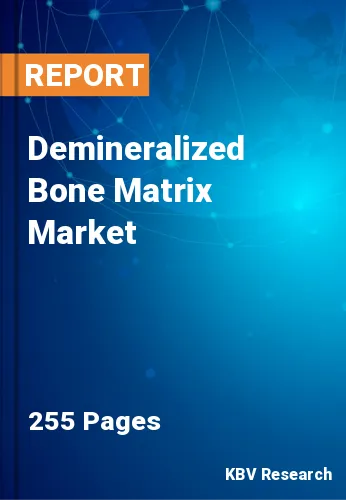“Global Demineralized Bone Matrix Market to reach a market value of USD 1.9 Billion by 2030 growing at a CAGR of 5.6%”
The Global Demineralized Bone Matrix Market size is expected to reach $1.9 billion by 2030, rising at a market growth of 5.6% CAGR during the forecast period.
Demineralized bone matrix paste formulations are designed to flow and adapt to irregular bone defects, filling voids and crevices with precision. Therefore, the paste segment captured $118.9 million revenue in the market in 2022. The paste consistency allows for easy manipulation and placement, ensuring complete coverage of the defect site and optimal contact with surrounding bone tissue for effective graft integration.

Musculoskeletal disorders, such as fractures, osteoporosis, and spinal fusion-related issues, are becoming more common due to factors like aging populations, sedentary lifestyles, and sports-related injuries. As these conditions become more prevalent, the demand for effective treatments like DBM rises. Therefore, the rising prevalence of musculoskeletal disorders is fuelling the expansion of the market.
Additionally, Spinal disorders, such as degenerative disc disease, spinal stenosis, and spinal fractures, are becoming more prevalent globally due to factors like aging populations and sedentary lifestyles. Spinal fusion surgeries are commonly performed to treat these conditions, and DBM is often used as a bone graft substitute or extender to promote spinal fusion and stabilize the spine. In conclusion, the increasing volume of spinal fusion and dental surgeries is driving the market's growth.
However, producing demineralized bone matrix involves complex processes such as demineralization, sterilization, and preservation, which require advanced technology and expertise. These manufacturing processes incur significant costs, passed on to the consumers. Therefore, the elevated expense associated with this impedes the market's growth.
The pandemic led to disruptions in the global supply chain, affecting the procurement, processing, and distribution of human donor tissue used in DBM production. Restrictions on movement, border closures, and logistical challenges impeded the transportation of tissue grafts, causing supply shortages and delays in product availability. Thus, the COVID-19 pandemic had a negative impact on the market.
Based on application, the market is categorized into spinal fusion, dental, joint reconstruction, hand, foot, & ankle, long bone, and craniomaxillofacial. In 2022, the spinal fusion segment registered 41.2% revenue share in the market. Spinal disorders such as degenerative disc disease, spinal stenosis, and vertebral fractures are increasingly prevalent, particularly among aging populations.

Based on product type, the market is divided into putty, fiber, sponge, paste, gel, and others. In 2022, the fiber segment held 15.9% revenue share in the market. The fibrous architecture of DBM fibers allows for interlocking with surrounding bone tissue, anchoring the graft material in place and minimizing the risk of graft migration.
Based on end-use, the market is divided into hospitals and outpatient facilities. The outpatient facilities segment attained 57.1% revenue share in the market in 2022. Outpatient facilities offer a convenient setting for patients to undergo these procedures without needing overnight hospitalization, reducing healthcare costs and improving patient satisfaction.
Free Valuable Insights: Global Demineralized Bone Matrix Market size to reach USD 1.9 Billion by 2030
Region-wise, the market is analyzed across North America, Europe, Asia Pacific, and LAMEA. In 2022, the Asia Pacific region generated 24.6% revenue share in the market. The Asia Pacific region is witnessing rapid technological advancements in orthopedic and dental surgery, including the adoption of minimally invasive techniques, computer-assisted navigation, and 3D printing.
| Report Attribute | Details |
|---|---|
| Market size value in 2022 | USD 1.2 Billion |
| Market size forecast in 2030 | USD 1.9 Billion |
| Base Year | 2022 |
| Historical Period | 2019 to 2021 |
| Forecast Period | 2023 to 2030 |
| Revenue Growth Rate | CAGR of 5.6% from 2023 to 2030 |
| Number of Pages | 255 |
| Number of Tables | 400 |
| Report coverage | Market Trends, Revenue Estimation and Forecast, Segmentation Analysis, Regional and Country Breakdown, Porter’s 5 Forces Analysis, Company Profiling, Companies Strategic Developments, SWOT Analysis, Winning Imperatives |
| Segments covered | Product Type, Application, End-use, Region |
| Country scope |
|
| Companies Included | Zimmer Biomet Holdings, Inc., Medtronic PLC, Johnson & Johnson, Stryker Corporation, Arthrex, Inc., Globus Medical, Inc., Berkeley Advanced Biomaterials, Xtant Medical Holdings, Inc., Orthofix Medical Inc., Institut Straumann AG |
By End-use
By Product Type
By Application
By Geography
This Market size is expected to reach $1.9 billion by 2030.
Increasing incidence of musculoskeletal disorders are driving the Market in coming years, however, High cost of demineralized bone matrix procedures restraints the growth of the Market.
Zimmer Biomet Holdings, Inc., Medtronic PLC, Johnson & Johnson, Stryker Corporation, Arthrex, Inc., Globus Medical, Inc., Berkeley Advanced Biomaterials, Xtant Medical Holdings, Inc., Orthofix Medical Inc., Institut Straumann AG
The expected CAGR of this Market is 5.6% from 2023 to 2030.
The Putty segment is generating highest revenue in the Market by Product Type in 2022; there by, achieving a market value of $828.3 million by 2030.
The North America region dominated the Market by Region in 2022, and would continue to be a dominant market till 2030; there by, achieving a market value of $750.8 million by 2030.
Our team of dedicated experts can provide you with attractive expansion opportunities for your business.

 Drivers
Drivers
 Restraints
Restraints
 Opportunities
Opportunities
 Challenges
Challenges
